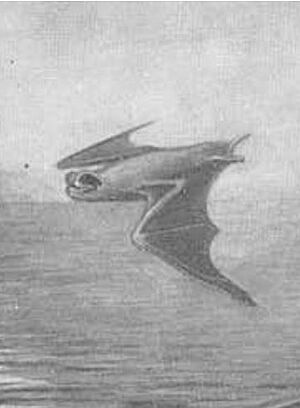Mongalla free-tailed bat facts for kids
Quick facts for kids Mongalla free-tailed bat |
|
|---|---|
 |
|
| Conservation status | |
| Scientific classification | |
| Genus: |
Mops
|
| Species: |
demonstrator
|
| Synonyms | |
The Mongalla free-tailed bat (Mops demonstrator) is a type of bat that belongs to the Molossidae family. These bats are known for their tails, which stick out freely from the edge of their tail membrane. You can find them in several African countries. These include Burkina Faso, Cameroon, Democratic Republic of the Congo, Ivory Coast, Ghana, Kenya, Mali, Sudan, and Uganda. They like to live in dry savanna areas, moist savannas, and grasslands that get wet or flooded during certain seasons.
Contents
Discovering the Mongalla Free-Tailed Bat
The Mongalla free-tailed bat was first officially described in 1903. A British scientist named Oldfield Thomas gave it the name Nyctinomus demonstrator. He studied an adult male bat found in Mongalla, South Sudan. Over time, scientists changed the bat's scientific name. This happens as they learn more about how different animals are related. Today, it is known as Mops demonstrator. It is also sometimes called the Mongalla mops bat.
How Scientists Classify Bats
Scientists group animals into categories to understand their relationships. The Mongalla free-tailed bat is part of the Mops group. It is very similar to the white-bellied free-tailed bat. Sometimes, these two bats were even thought to be the same kind. Scientists are still studying how all the bats in the Mops group are related to each other.
Protecting the Mongalla Bat
The International Union for Conservation of Nature (IUCN) lists the Mongalla free-tailed bat as a species of least concern. This means it is not currently in immediate danger of disappearing. However, scientists believe that the number of these bats is slowly going down.
Threats to Their Habitat
These bats face challenges in their natural homes. One big problem is habitat loss. This happens when large trees, where the bats like to rest, are cut down. Another threat is desertification, especially in the northern parts of their range. Desertification is when land becomes dry like a desert.
Where They Are Protected
Even with these threats, some Mongalla free-tailed bats live in safe places. For example, they can be found in Garamba National Park in the Democratic Republic of the Congo. Protecting these areas helps keep the bats safe.


